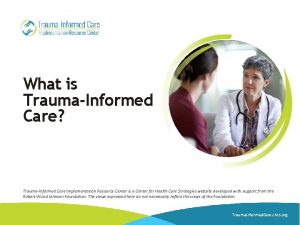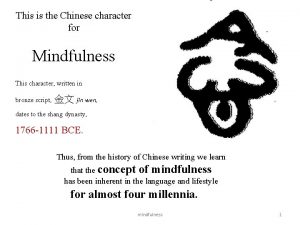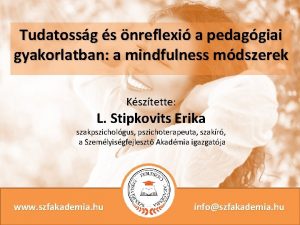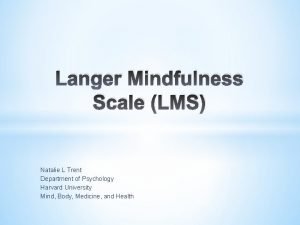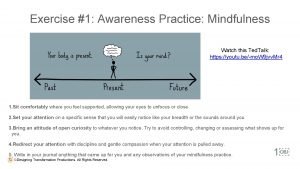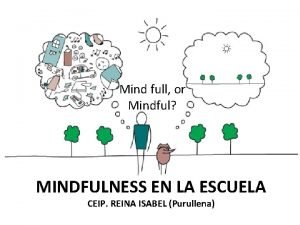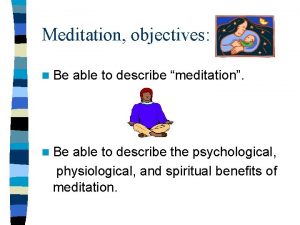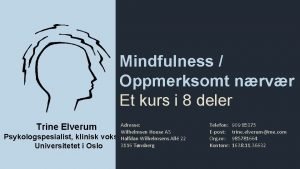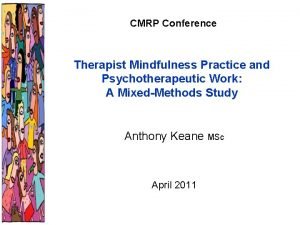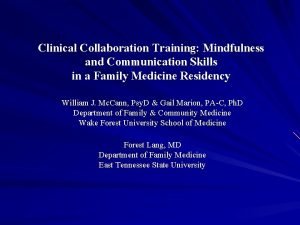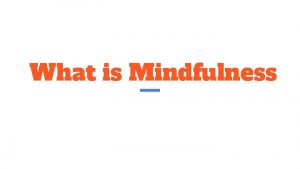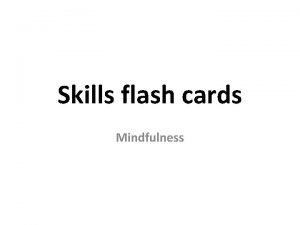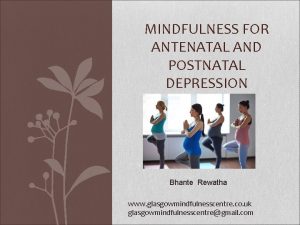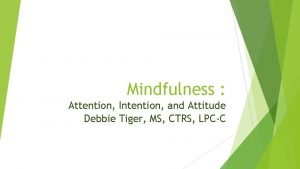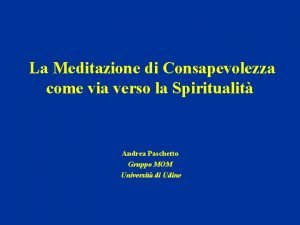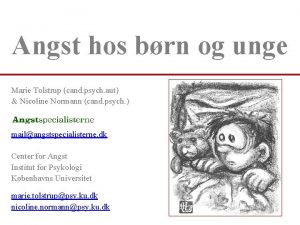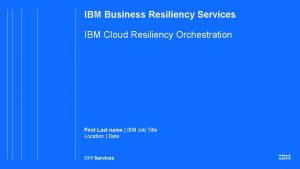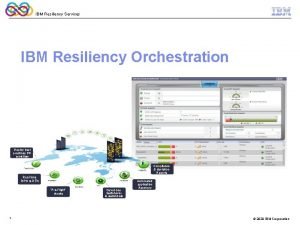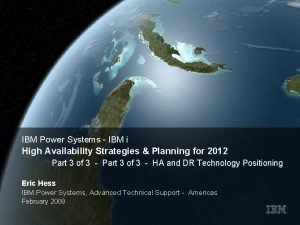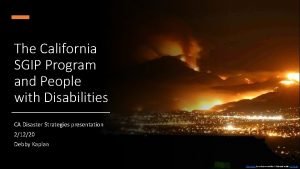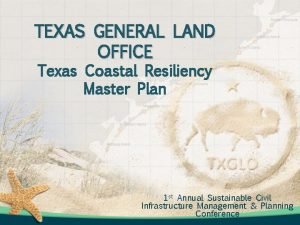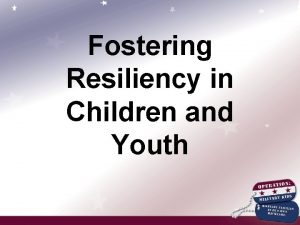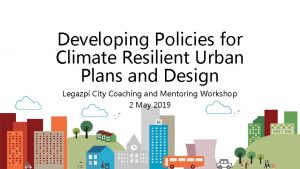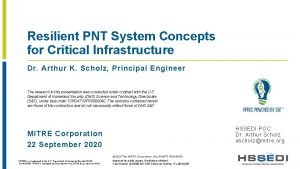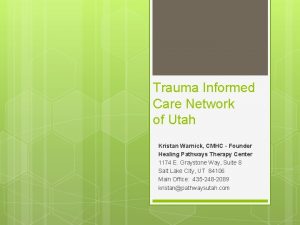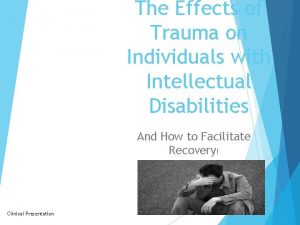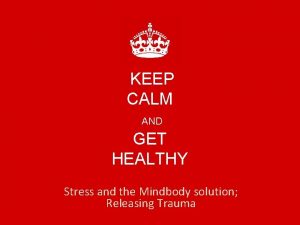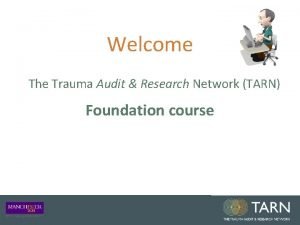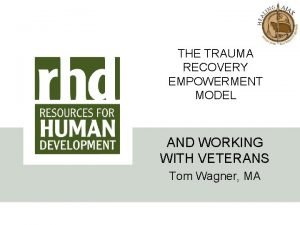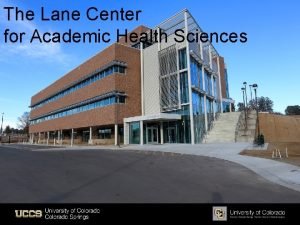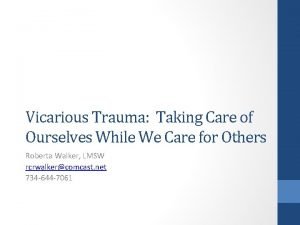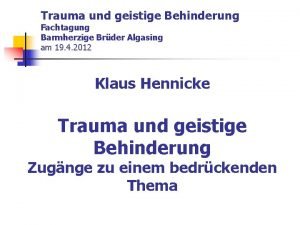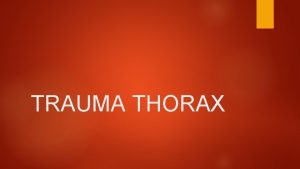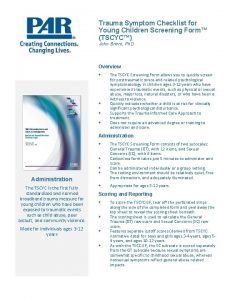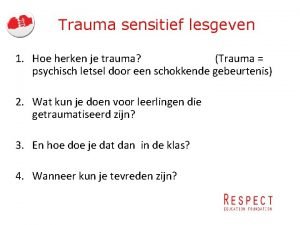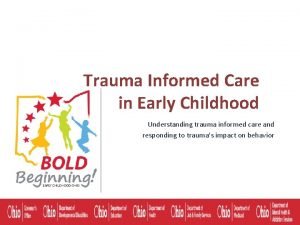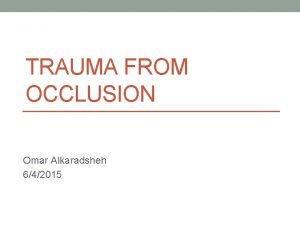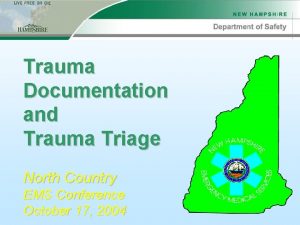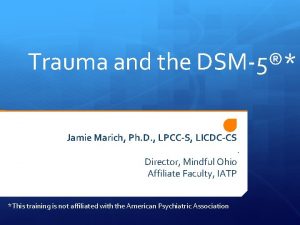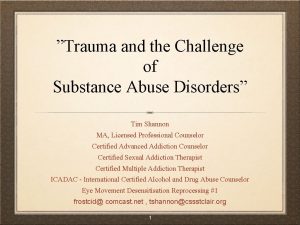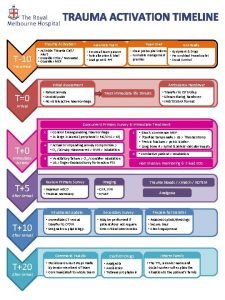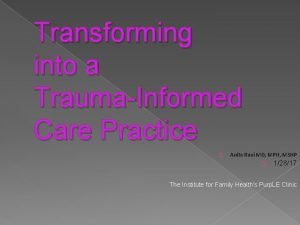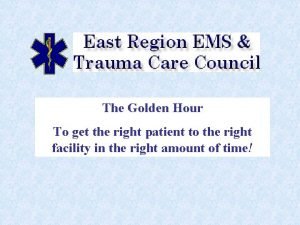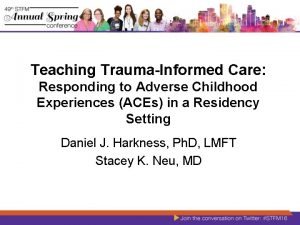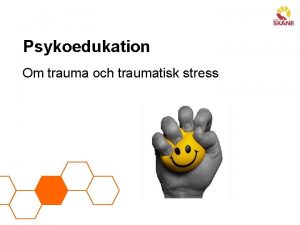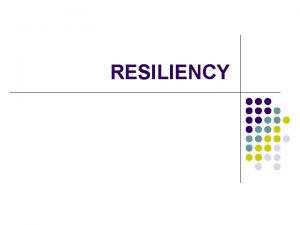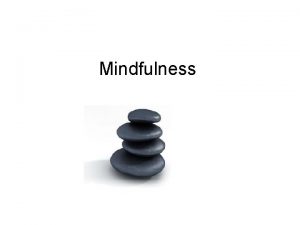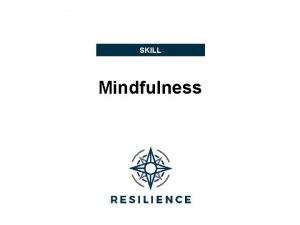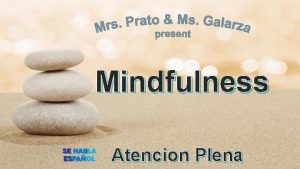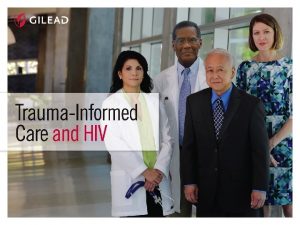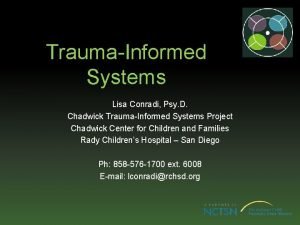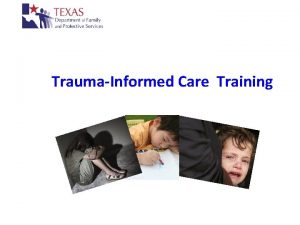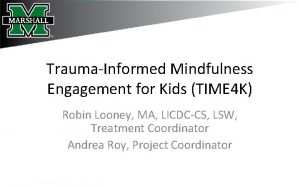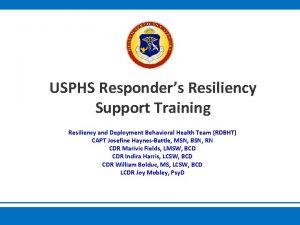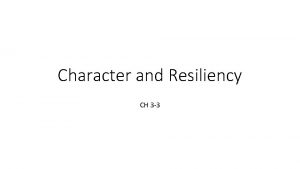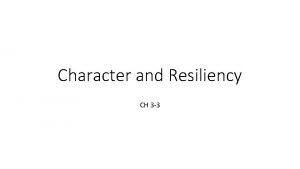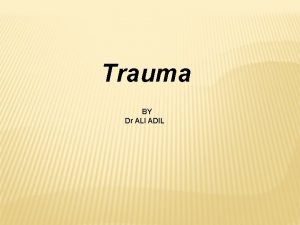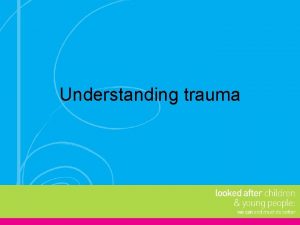Trauma and Mindfulness TraumaInformed Strategies Supporting Resiliency and


















































- Slides: 50

Trauma and Mindfulness Trauma-Informed Strategies Supporting Resiliency and Competency in Children Presenter: Sara Sheikh, LCSW-C

Workshop Overview �Why yoga and mindfulness tools work as a complimentary intervention to promote emotional regulation and pro-social skills in children.

Workshop Overview �Why yoga and mindfulness tools work as a complimentary intervention to promote emotional regulation and pro-social skills in children. �What are key trauma-informed mind-body practices and structures.

Workshop Overview �Why yoga and mindfulness tools work as a complimentary intervention to promote emotional regulation and pro-social skills in children. �What are key mind-body practices and structures. �What outcomes can we expect or aim for.

Workshop Overview �Why yoga and mindfulness tools work as a complimentary intervention to promote emotional regulation and pro-social skills in children. �What are key mind-body practices and structures. �What outcomes can we expect or aim for. �How can we integrate these tools in a variety of settings.

Workshop Overview �Why yoga and mindfulness tools work as a complimentary intervention to promote emotional regulation and pro-social skills in children. �What are key mind-body practices and structures. �How can we integrate these tools in a variety of settings. �What outcomes can we expect or aim for. �Questions and reflections.

What We Know… �About childhood trauma � According to the NCTSN there are 12 types of trauma children might experience.

What We Know…

What We Know… �About childhood trauma � Shock Trauma- unexpected, horrifying or terrorizing event that happened too fast for the nervous system to assimilate. � Developmental Trauma- an ongoing mis-attunement with the parent-child relationship (such as lack of mirroring, neglect, abuse, etc. ) (Levine)

What We Know… �About childhood trauma � Children may display internalizing and externalizing symptoms such as PTSD, anxiety, depression, low self -esteem, depression. (1)

What We Know… �About childhood trauma � At risk of experiencing PTSD, anxiety, depression, low self-esteem, depression. (1) � Abuse and neglect are linked to poor attachment and emotional regulation, aggression, and learning difficulties. (2)

What We Know… �About childhood trauma � At risk of experiencing PTSD, anxiety, depression, low self-esteem, depression. (1) � Abuse and neglect are linked to poor attachment and emotional regulation, aggression, and learning difficulties. (2) � Chronic Stress activates and overwhelms the stress responses of children and effects brain development. (3)

What We Know… �About childhood trauma � ACES triggers neurobiological events and can alter brain development and impair the stress response system. (4)

What We Know… �About childhood trauma � ACES triggers neurobiological events and can alter brain development and impair the stress response system. (4) � Stress Exposure affects neurotransmitter, neuroendocrine and immune systems. (5)

What We Know… �About the Sympathetic Nervous System: Stress Response � Activated by anger and anxiety � Prepares the body for fight or flight (Freeze? ) � Increased heart rate � Increased blood flow to lungs and limbs � Pupils dilate

What We Know… �The Parasympathetic Nervous System � The relaxation phase- counteracting the stress response � Decreased heart rate � Increased digestive activity and blood flow

What We Know… �About childhood trauma � Trauma symptoms appear when the energy mobilized for fight or flight is not discharged and remains stuck inside the body. (6)

What We Know…

What We Know… �Unresolved Trauma Effects the Brain and Body � Emotional � Behavioral � Social � Cognitive

What We Know… �Emotional � Emotional regulation � Intense emotions drive reactions � Physiological Regulation � Body Awareness � General sense of trouble and unease

What We Know… �Behavioral � Increase in risk taking behaviors. � Capacity to self-regulate is damaged and one responds impulsively and reflexively. � Decrease in self-care and preventative behaviors.

What We Know… �Social � Ability to create healthy attachments � Ability to maintain attachments

What We Know… �Cognitive � Attention and concentration � Alterations in neurobiological structures � Ability to reason and process information correctly diminishes

What We Know… �It’s time to put a mind-body tool into practice!!!

What We Know… �The Reparative Power of Yoga and Mindfulness

What We Know… � The Reparative Power of Yoga and Mindfulness is the combination of awareness, centering, and being present. It is the awareness of your thoughts, emotions, actions and energy. It is the ability to get centered and stay centered in all situations. It is the ability to not let internal and external distractions take you from the current moment. This leads to the development of empathy, compassion, love, balance and harmony. – Holistic Life Foundation

What We Know… �The Reparative Power of Yoga and Mindfulness � Studies have demonstrated how yoga improves resilience to stress and emotional regulation. (8)

What We Know… �The Reparative Power of Yoga and Mindfulness � Yoga may regulate the functioning of the Hypothalamic -Pituitary-Adrenal (HPA) Axis and Sympathetic Nervous System (SNS), the systems responsible for brain-body connections, and the connection between traumatic experiences and future mental and physical illness. (9)

What We Know… �The Reparative Power of Yoga and Mindfulness � Mindfulness and yoga based practices have been found to regulate the body-brain pathways that cause stress following traumatic experiences, thereby reducing mental and/or physical illness. (9)

What We Know… �The Reparative Power of Yoga and Mindfulness � Medical and behavioral research shows that yoga practice override the stress response, lowers blood levels of cortisol, which clears the slate for learning and develops both mental and physical focus. (7)

What We Know… �Key trauma-informed practices and structures

Visual Schedule… �Opening Rituals � Easy Pose � Welcome/Check-in � Visual Schedule � Group Agreements � Daily Practice Review (10)

Visual Schedule… �Movement Activities � Breathing Exercise � Yoga Flow � Yoga Game

Visual Schedule… �Learning � Week 1 Theme: Introduction to Yoga Group. � Group Discussion: What do you know about yoga? � How does yoga help us? � Yoga at home. � Daily Practice Handout

Visual Schedule… �Closing Rituals � Deep Relaxation � Easy Pose � Reflection � Clean-up

Visual Schedule… �Group Agreements � Safety � Boundaries � Social Skills � Participation � Responsibility for Self

What We Know…

Movement Activities… �Games and Skills � Yogi Says- Body Awareness, Attention, Following Directions � Red Light, Green Light yoga- Attention, Impulse Control, Frustration Tolerance � Balancing Tree – Self-Regulation, Attention/Focus, Centering, Body Awareness � Mountain or Sand Castle- Body Awareness, Grounding, Assertiveness

Movement Activities… �Games and Skills � Partner Poses- Attention, Awareness of Self and Others, Attunement � Mirror, Mirror on the Mat- Attention, Self-Regulation, Attunement, Organizing, Competency � Feelings Charades-Body Awareness, Awareness of Self and Others � Stop/Safe Space- Centering, Boundaries, Attention, Assertiveness (10)

Movement Activities…

Movement Activities…

Learning Themes… � Body Awareness � Focus on the Breath � Focus on Relaxation � Self-Awareness and Emotions � Stress and the Mind � Self Care � Awareness of Others � Teamwork (10. 11)

Daily Practice Handout…

Visual Schedule… �Closing Rituals � Deep Relaxation � Easy Pose � Reflection � Clean-up

Underpinning concepts & Outcomes we aim for … �Safety & Personal Boundaries �Self-Regulation/Resilience �Self-Soothing �Competency �Self-Awareness �Self-Esteem (10, 11)

What We Know… �How can we integrate these tools in a variety of settings. � Considerations �Space/Safety �Materials/Supplies �Behavior Management �Caregiver Engagement �Facilitator- “Be the change you want to see in the world”

Questions & Reflections…

Contact Information �Sara Sheikh, LCSW-C sheikhs@childrensguild. org

References � 1. Hunt KL, Martens PM, Belcher HM. (20111). Risky business: Trauma Exposrure and rate of PTSD in African American children and adolescents. Journ of Traumatic Stress, 24, 365 -369. � 2. Van Der Kolk B. Psychological Trauma. � 3. Feasibility and Preliminary Outcomes of a School-based Mindfulness Intervention for Urban Youth. Mendelson T, et al. J Abnorm Child Psychol. 2010. � 4. De Bellis MD. (2003). The Neurobio 0 logy of PTSD Across the Life Cycle. C. Soares & S. Gershon (eds), The Handbook of Medical Psychiatry(pp. 449 -466). New York: Marcel Decker. � 5. De Bellis, MD. (2005). The psychobiology of neglect, . Child Maltreatment, 10, 150 -172. � 6. Levine, P. (1997). Waking The Tiger. Berkeley, CA: North Atlantic Books. Somatic Experiencing Training Manual. � 7. Mind-Body Resources for Working with Those at Risk. 2 nd Edition. Guber TL, Khouri H. Yoga Ed. 2008.

References 8. Abadi, MS. Venkatasoan, JMS. (2008). Effects of Children with Attention-Deficit/Hyperactivity Disorder. Psychological Studies, 53, 154 -159. 9. Ross, G. (2007), Beyond the Trauma Vortex Into the Healing vortex, manual sponsored by the International Trauma Healing Institute. 10. Yoga Based Psychotherapy: A Group Protocol for Children. Beltran M, Brown-Elhillal AN, Held AR, Muyu J, et al. The Family Center at Kennedy Krieger Institute. 2014. Baltimore, Maryland. 11. Yoga-based Psychotherapy Groups for Boys Exposed to Trauma in Urban Settings. Beltran M, Brown -Elhillal AN, Held AR, Ryce PC, Ofonedu ME, Hoover. DW, Ensor KM, Belcher HM. Altern Ther Health Med. 2016 Jan-Feb: 22(1); 39 -46. Yoga Ed Tools for Teachers Children Manual. First Edition. Caleda B, Bond J. Yoga Ed Corp. 2014. Yoga Ed Tools for Teachers Children’s Lesson Plans. Yoga Ed Corp. 2014. Holistic Life Foundation, Baltimore, MD
 Traumainformed care
Traumainformed care Yun xin
Yun xin Brainpop precision and accuracy quiz answers
Brainpop precision and accuracy quiz answers Mindfulness gyerekeknek
Mindfulness gyerekeknek Langer mindfulness scale
Langer mindfulness scale Mindfullness ted talk
Mindfullness ted talk Mind full
Mind full Describe meditation
Describe meditation Else bisseling
Else bisseling Mindfulness definisjon
Mindfulness definisjon Mindfulness
Mindfulness Mindfulness for collaboration
Mindfulness for collaboration Mindfulness circle
Mindfulness circle Bodily sensations examples
Bodily sensations examples Mindfulness-based stress reduction
Mindfulness-based stress reduction Miss attitude
Miss attitude Franco fabbro
Franco fabbro Detached mindfulness øvelser
Detached mindfulness øvelser Bcrs business continuity
Bcrs business continuity Ibm cloud resiliency
Ibm cloud resiliency Resiliency orchestration
Resiliency orchestration Ibm geographically dispersed resiliency for power systems
Ibm geographically dispersed resiliency for power systems Ibm i high availability
Ibm i high availability Sgip equity resiliency program
Sgip equity resiliency program Texas glo gis
Texas glo gis Protective factors definition
Protective factors definition Calactite
Calactite Resiliency
Resiliency Trauma awareness and treatment center utah
Trauma awareness and treatment center utah Triune brain theory and trauma
Triune brain theory and trauma Limbic system and trauma
Limbic system and trauma Tarn database
Tarn database Trauma recovery and empowerment model
Trauma recovery and empowerment model Uccs health circle
Uccs health circle Vicarious traumatisation
Vicarious traumatisation Trauma gestig behindert
Trauma gestig behindert Jenis jenis trauma thorax
Jenis jenis trauma thorax Trauma symptom checklist for young children
Trauma symptom checklist for young children Trauma sensitief lesgeven
Trauma sensitief lesgeven 4 r's trauma informed care
4 r's trauma informed care Lgbtq trauma informed care
Lgbtq trauma informed care Glickman's concept
Glickman's concept Miemss trauma decision tree
Miemss trauma decision tree Examples of little t trauma
Examples of little t trauma Enmeshment
Enmeshment How to do a trauma timeline
How to do a trauma timeline Dr anita ravi
Dr anita ravi The golden hour ems
The golden hour ems Trauma-informed care cheat sheet
Trauma-informed care cheat sheet Nethercutt emergency center
Nethercutt emergency center Psykoedukation ptsd
Psykoedukation ptsd
